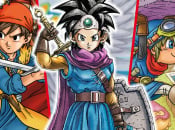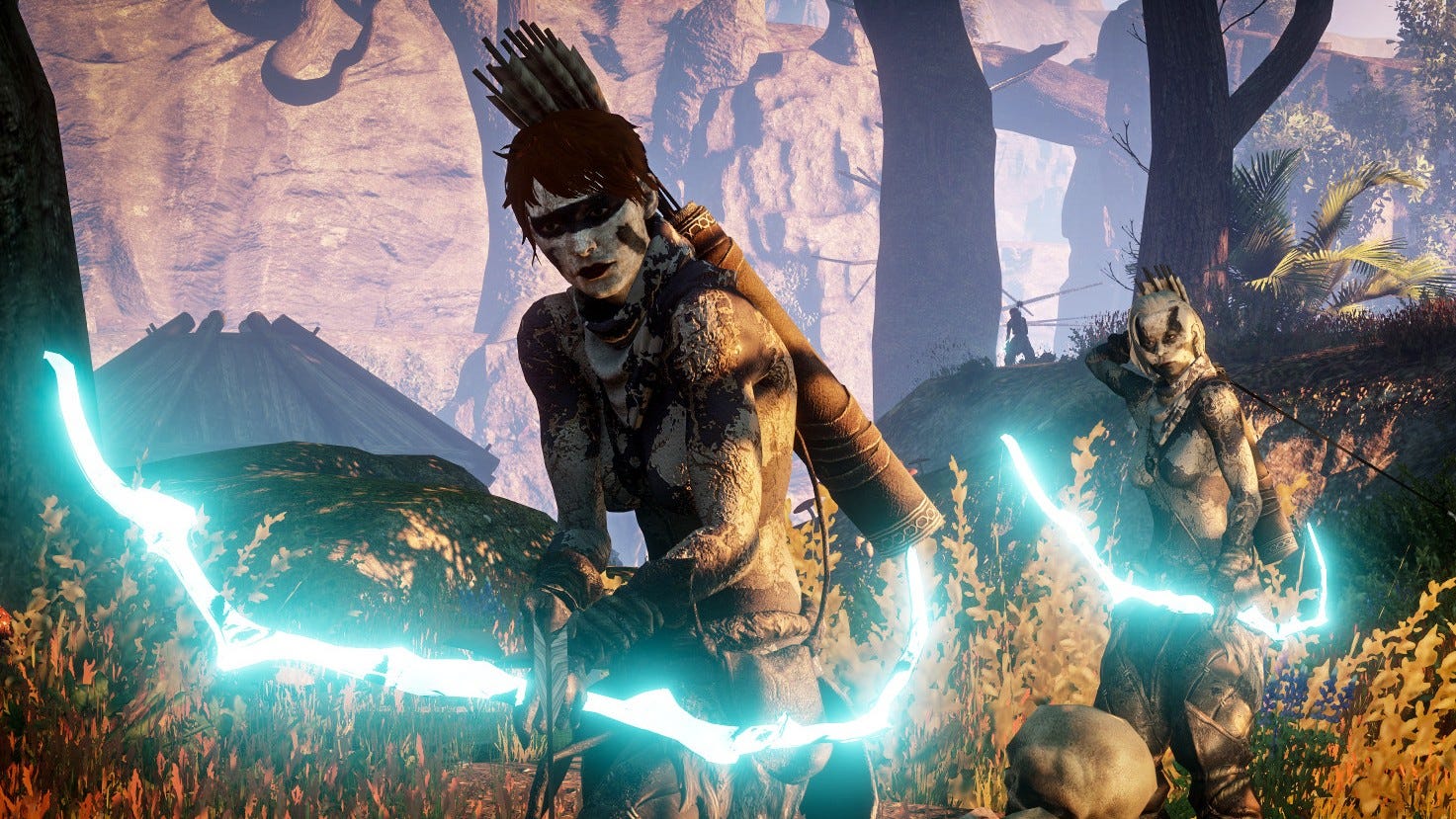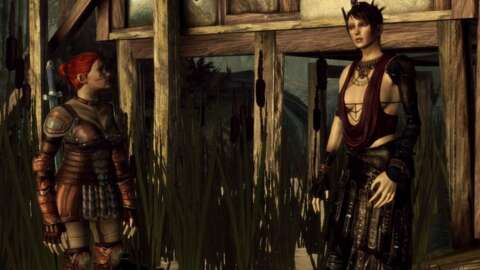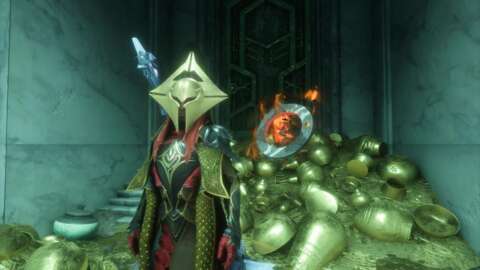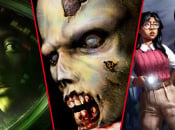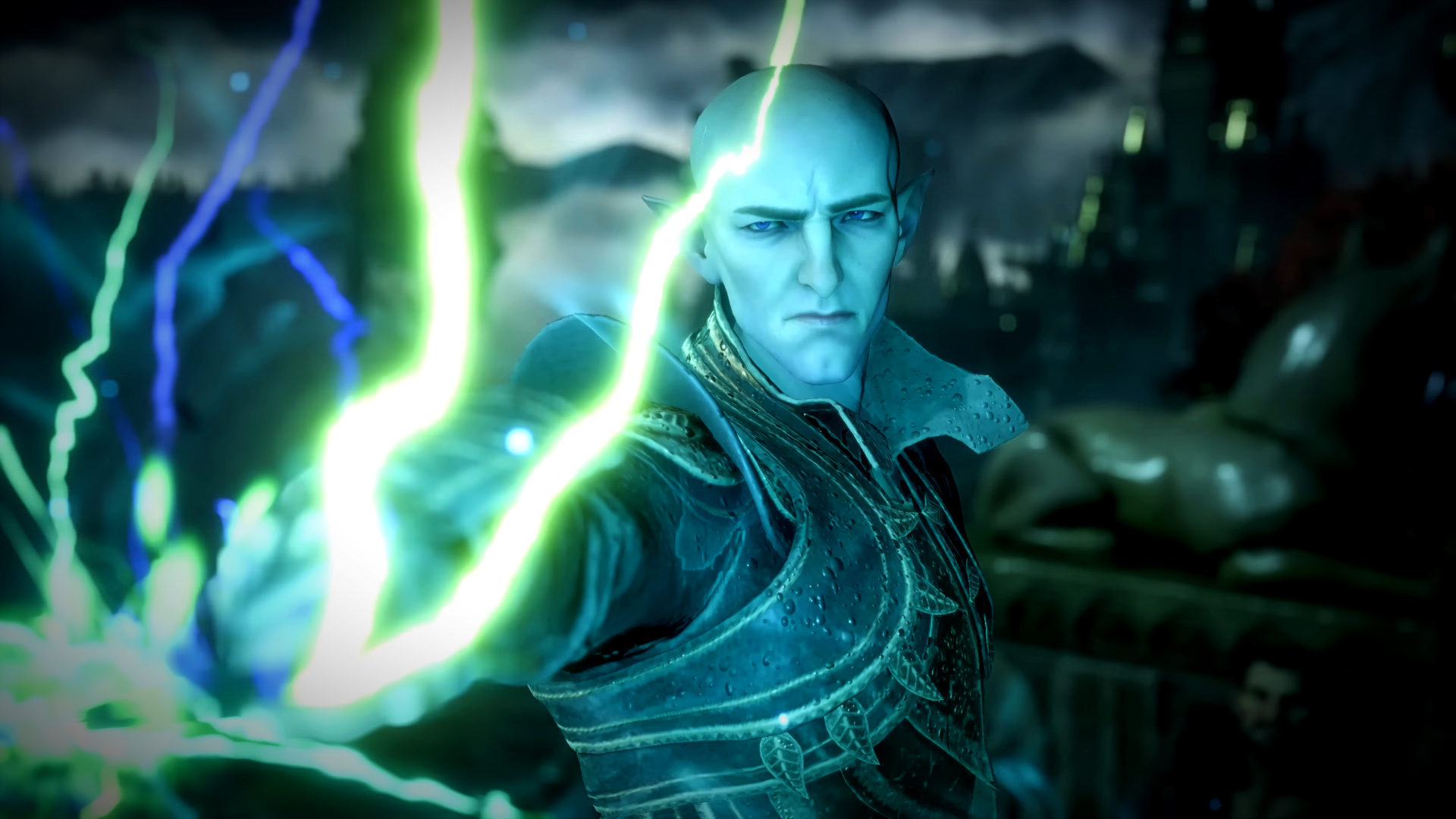
Update: To celebrate the release of Dragon Quest III HD-2D Remake, we’ve completely overhauled our Best Dragon Quest list to include every single Dragon Quest game released on a Nintendo system in the West. Enjoy!
Dragon Quest – or maybe you know it better as Dragon Warrior – might be one of the most well-known JRPG franchises in the world. It’s known for bringing crowds in Japan thanks to its cosy, comfy gameplay structure, adventurous stories, and homely feel. Dragon Quest is RPG comfort food at its finest.
With such a wide variety of games — with spin-offs ranging from Minecraft-likes to monster-catching adventures — you might be wondering “What’s the best Dragon Quest?” Well, we’ve compiled this list of every single Dragon Quest game released on a Nintendo system, including remakes, spin-offs, and multiple versions, though no imports – sorry, Dragon Quest X!
With that out of the way, a wild list appears!
28. Infinity Strash: Dragon Quest The Adventure of Dai (Switch eShop)
Infinity Strash: Dragon Quest The Adventure of Dai suffers from a chronic lack of focus. The vibrant visuals and fun combat can’t make up for the fact that you’ll spend hours doing little more than watching static images tell the plot of the anime. The result is a game that will frustrate action RPG fans with a lack of action and fails to do justice to the story it is trying to tell.
You might be curious if you’re a huge — and we mean huge — fan of Dragon Quest, or the manga/anime it’s based on, but the latter is perhaps the best way to experience this spin-off.
27. Dragon Quest Wars (DSiWare)
Developed by Intelligent Systems, if you can somehow curb your expectations of Dragon Quest Wars being a typical Dragon Quest-style RPG experience and accept it for the simple, yet enjoyable strategy title it is, then you’ll find a very fulfilling and playable game here.
The stylus control could have used a little tightening up and the single-player experience can be a bit bland, but the local multiplayer modes (if you can find a friend with the game for some DS Wireless play) more than make up for its shortcomings. It’s another DSiWare offering that further proves the adage that sometimes less is more.
26. Dragon Warrior II (NES)
Available on Switch as Dragon Quest II: Luminaries of the Legendary Line, this got a Japan-only remake for Super Famicom where it was bundled with the original game, and this bundle was also ported to a Game Boy Color cart — which was released in North America — as the imaginative titled Dragon Quest I & II.
Set 100 years after the first game, Dragon Warrior II did what any sequel should: it built on what came before and sanded away some rough edges from the original. This second entry is one of the hardest games in the series, so these days — especially with ten other Quests vying for your time and attention — it’s probably best left to diehard fans. It remains, however, an important evolutionary step and a game which put DQ on the path to franchise fame and fortune.
25. Dragon Warrior (NES)
The first Dragon Quest title, Dragon Warrior set the template that the heroic series would follow. A huge success in Japan from the get-go, it took many years (and many games) for this classic JRPG series to achieve mainstream success in the West. Fortunately, publisher Enix didn’t give up and these days it feels a bit odd to see the word ‘Warrior’ in this game’s title.
In the West it’s also available on Switch (and on Game Boy Color), and it’ll also be on Switch thanks to the HD-2D Remake in 2025.
24. Dragon Quest Swords: The Masked Queen and the Tower of Mirrors (Wii)
An on-rails first-person RPG using motion controls wasn’t on anyone’s cards back on the Wii. But Dragon Quest Swords surprised everyone by changing up the Dragon Quest formula. Even for a spin-off, it was pretty different. And perhaps that’s why it isn’t as well-loved as many other games in the franchise.
Still, the motion controls are pretty good, and for an “on-rails shooter” type of game, it’s pretty accessible, as there’s no game over screen and you can set your own pace. Still, this may not be the best representation of Dragon Quest, but you might want to check it out if you’re a die-hard series fan.
23. Dragon Quest II: Luminaries of the Legendary Line (Switch eShop)
Dragon Quest II is a step up from the first in many ways — it’s much more open, and you have your first party of characters in the series — but this is also the most difficult game in the main series by far, and is often considered the black sheep.
But it’s still a solid RPG, featuring tons of Dragon Quest staples and a fun and simple combat system that would keep fans coming back for more over the years. Even the weakest mainline Dragon Quest game is good, and while the HD-2D remake is on the horizon, you can’t go wrong picking up the mobile port for cheap.
22. Dragon Quest (Switch eShop)
Definitely not the prettiest version of Dragon Quest out there, the mobile port — which came to Switch in 2019 — is currently the only way to play the original Dragon Quest on Switch, at least until the HD-2D remake comes out.
However, while it is very basic by modern-day standards, this game laid the foundation for many JRPGs going forward. It’s a breezy, enjoyable adventure that’s perfect to play under a blanket with a cup of tea, and you can’t summarise the Dragon Quest series much better than “cosy”.
21. Dragon Quest III: The Seeds of Salvation (Switch eShop)
Dragon Quest III might be slightly more expensive than its two younger brothers on the Switch eShop, but it stands tall as a great way to explore the world of Dragon Quest for the first time. Even when compared to modern JRPGs, Dragon Quest III still stands tall as one of the best in the genre.
The HD-2D Remake is easily the best version of this game, but the mobile port is still solid, giving you an even more “pure Dragon Quest experience. Whatever version you play, we can promise that you won’t be disappointed.
20. Dragon Quest Treasures (Switch)
If you go in expecting to sink 100 hours into Dragon Quest Treasures or think you’ll get the same kind of intricate plot that the series is known for, you’ll come away disappointed. However, if you are a younger gamer who is itching for a taste of what a JRPG is like, or you just want something laid back to tackle, there is a lot of fun to be had here.
Everything you’d expect in a JRPG is in this game, just stripped back to the basics, all adorned with that timeless Dragon Quest charm. It’s a lovely little spin-off, and if you’re a big fan of Erik from Dragon Quest XI, it’s well worth checking out.
19. Dragon Quest Builders (Switch)
Both classic Dragon Quest RPG and Minecraft-style building sim, Dragon Quest Builders takes just enough ingredients from each side of the developmental kitchen and gently stirs them into a dish that never manages to overpower either of its core mechanics.
If you’ve ever wanted to try Mojang’s ubiquitous hit but found it a little too intimidating in its vagueness, then this is the alternative for you. Fun, empowering and Dragon Quest to a tee; its combat and camera can be a little erratic, but they never manage to derail your new building adventure.
18. Dragon Warrior I & II (GBC)
Dragon Warrior I & II pulls together the first two NES / Famicom Dragon Quest games – a pair of RPGs that arguably established the template for the genre in Japan — in lovely handheld form. Enix remastered the two games for release on the Super Famicom in 1993, later porting the games to the Game Boy Color in 1999 (2000 in North America).
While the visuals and sound take an obvious hit, a host of improvements are also included which improve both games. If you don’t fancy pulling the Game Boy Color out of the cupboard, then you can experience both of these titles on Switch. And very soon, both will be bundled together in glorious HD-2D.
17. Dragon Quest VII: Fragments of the Forgotten Past (3DS)
An island-hopping adventure spanning space and time originally released on PlayStation, Dragon Quest VII is a JRPG masterpiece. If you played the PlayStation original, this 3DS version is as perfect a remake as you could ask for, with beautiful 3D graphics, a smartly streamlined opening, and lots of welcome quality-of-life updates. This journey through Estard showcases great writing, a fun class system, lovely animations and a stellar soundtrack which make for a fully engrossing adventure throughout.
It’s a massive game, but don’t let that scare you off; with short story-style pacing and a huge variety of settings, speech patterns, and scenarios, it feels less like an epic tome and more like a shelf-full of storybooks stuffed into a little 3DS cart. This game is an absolute pleasure and a must-play for RPG fans.
16. Dragon Quest Monsters: Joker (DS)
Dragon Quest Monsters: Joker is another quality spin-off in the Dragon Quest series, and as the fourth game in the Monsters series (and the first game to use online play), it innovates in fun ways. Taking the skill system from Dragon Quest VIII and combining it with the monster-fusing system, there’s a lot of customisation on the table.
The plot is also really fun, too, bringing the best aspects of Dragon Quest to a solid spin-off. Even with online play no longer active, this is a fun little adventure that all Dragon Quest fans should check out.
15. Dragon Quest VI: Realms of Revelation (DS)
Originally a Japanese exclusive until this Nintendo DS remake came to the West, Dragon Quest VI: Realms of Revelation might not be as flashy or intricate as something like Dragon Quest IX but that certainly doesn’t keep the game from being every bit as charming and engaging.
Retaining the 16-bit style of the 1995 Super Famicom original and not deviating a great deal from the classic formula, it upgrades various aspects to make the version we did get in the West look and feel like a much more modern experience. Realms of Revelation is yet another fantastic addition to the impressive DS RPG library and a great way to revisit a classic.
14. Dragon Warrior III (NES)
Dragon Warrior III (or Dragon Quest III: The Seeds of Salvation) put the cap on a trilogy (at the time) of influential RPGs which would shape the genre. Set prior to the original game, often called the Erdrick Trilogy, it added a plethora of refinements to the turn-based gameplay and open-world adventuring, including a day/night cycle.
It got a Super Famicom remake which never came to the West, although an excellent Game Boy Color version did arrive in 2001, and you can also play it on Switch, both via the mobile port and the extremely good HD-2D Remake (which is our preference).
13. Dragon Quest Monsters: Joker 2 (DS)
The great thing about Dragon Quest Monsters: Joker 2 is that once the story ends the real fun begins. With an almost limitless number of monster and skill variations, you’ll find plenty to do even after the credits roll.
Square-Enix has concocted another enjoyable adventure and bundled in a wealth of local and online monster fighting and trading functions for players to sink their teeth into. While you can’t help but wish the adventure mode was designed with a little more ambition, it’s difficult to fault given the nearly infinite amount of replay value the tournament aspects bring to the table.
12. Dragon Warrior Monsters 2: Tara’s Adventure & Cobi’s Journey (GBC)
With over 300 monsters to capture, Dragon Warrior Monsters 2 is a beast (sorry) of a game, and really builds on the good work seen in the original. Taking a leaf out of Pokémon’s book, the game is available in two versions: Cobi’s Journey and Tara’s Adventure. While both titles are essentially identical in terms of story, they possess unique monsters and keys which are only present in that particular version. If you want the full experience then you’ll need both games.
The vast array of monsters on offer really does make this a fantastic RPG experience. Square Enix would remaster Dragon Warrior Monsters 2 for the Nintendo 3DS with Dragon Quest Monsters 2: Iru and Luca’s Marvelous Mysterious Key (only in Japan, though) which included both versions rather than splitting them into two releases.
11. Dragon Warrior Monsters (GBC)
There are very few Game Boy titles that contain the mammoth amount of playability that Enix has been able to squeeze into Dragon Warrior Monsters. While the quest itself will easily keep you engrossed, it’s the monster capturing and breeding that will keep you coming back to the title for countless hours, even after you’ve likely finished the quest itself.
Whether you’re a fan of the Dragon Quest series or not, you owe it to yourself to check this amazing title out. It’s easily one of the most engrossing Game Boy titles ever created and a true testament to what could be done on the Game Boy system when developers took the time to get it right.
10. Dragon Warrior III (GBC)
A fine handheld entry in this seminal line of JRPGs, Dragon Warrior III is based on the Super Famicom remake of the original Famicom Dragon Quest III and it’s one of the most ambitious RPGs available on the Game Boy Color, filling out a (then) massive 32 Mb ROM cart.
This version boasts a wide range of improvements when compared to the original, including a new character class (thief), mini-games, medals, dungeons and a brand-new introduction sequence. It’s little wonder, then, that Dragon Warrior III is considered to be one of the finest examples of the genre on Nintendo’s handheld system. Whether it’s here, the NES, or the Switch remake, you can’t go wrong.
9. Dragon Warrior IV (NES)
The final NES/Famicom entry in Chunsoft’s seminal RPG series, 1992’s Dragon Warrior IV (or Dragon Quest IV: Chapters of the Chosen as it’s more commonly known these days) would be the last title in the series to arrive in the West for some time. It featured five chapters, each of which concentrates on one of the aforementioned ‘chosen’ characters. It was also the first of the mainline DQ series to get its own spin-off titles: Torneko no Daibōken: Fushigi no Dungeon featured this game’s merchant, Taloon, and was the very first game in Chunsoft’s Mystery Dungeon series, no less.
The Nintendo DS is the best way to enjoy the game these days if you can find it for a reasonable price. But the fantastic character chapter-based structure means this RPG feels extremely fresh, wherever you play it.
8. Dragon Quest Builders 2 (Switch)
Dragon Quest Builders 2 is a much more confident game than its predecessor, boldly expanding on its concepts, fixing many of its flaws, and providing an overall more robust adventure experience that fans won’t want to miss out on. The melding of JRPG conventions with the open-ended and creatively focused sentiments of sandbox gameplay proves to go over much smoother than you’d expect, especially now that Square Enix knows what it’s doing with this sub-series.
Charming characters, a well-tuned gameplay loop, and near-endless replayability ensure that you’ll be coming back to this one for quite some time, and though the performance issues are disappointing, Dragon Quest Builders 2 is still worth it.
7. Dragon Quest Heroes: Rocket Slime (DS)
This spin-off title of the venerable RPG series is a sequel to a Japan-only Game Boy Advance title which follows the exploits of a Slime named Rocket. A cute spin-off it may be, but Dragon Quest Heroes: Rocket Slime is anything but a quick cash-in.
As with many spin-offs, Dragon Quest creator Yuji Horii had a hand in this and while it’s skewed towards a younger audience, developer Tose crafted a great experience that took advantage of the host platform’s features and is still worth tracking down today.
6. Dragon Quest III HD-2D Remake (Switch)
It’s been a long time coming, but Dragon Quest III HD-2D Remake largely lives up to expectations. Performance issues aside, this is a faithful adaptation of a treasured RPG classic that elevates its strongest aspects while doing its best to make up for any shortcomings. Some may be put off by its relative simplicity but, refreshingly, it neither overstays its welcome nor spreads itself thin with too many half-baked ideas.
It goes without saying that fans of the original will want to snap this up, but if you’re looking for a good ‘entry-level’ RPG or you just want to know what the long-running franchise is all about, Dragon Quest III is the game for you. This is the definitive version of Dragon Quest III in our eyes.
5. Dragon Quest IV: Chapters of the Chosen (DS)
A remake of the Chunsoft-developed NES game, Dragon Quest IV: Chapters of the Chosen was made by ArtePiazza, a studio responsible for a number of enhanced remakes of the Dragon Quest series (and later the Super Mario RPG remake).
This DS version featured a new translation and an extra chapter on top of the original game’s five, but the base game is very much the winning RPG epic it was when it was known as Dragon Warrior IV in North America way back in 1992. This game appeared again in 2014 on Android and iOS devices, but the DS version is the best way to revisit it.
Players can also get a hit of DQIV nostalgia by taking control of the Hero from this game (Solo) in Super Smash Bros. Ultimate, one of the four available versions of the DLC fighter.
4. Dragon Quest IX: Sentinels of the Starry Skies (DS)
A game made exclusively for Nintendo DS, sometimes you can’t help but marvel at how developers were able to squeeze home console-sized RPG epics onto tiny handheld systems with the most modest of specs, and Dragon Quest IX: Sentinels of the Starry Skies stands as an impressive feat.
Boasting a wealth of new gameplay features, Wi-Fi compatibility, and multiplayer action as well, this remains a significant milestone in portable gaming and helped increase Western interest in this hallowed Japanese series. It’s a shame the online features don’t work, so for now, we hope Dragon Quest IX will someday get ported to a new console.
3. Dragon Quest VIII: Journey of the Cursed King (3DS)
Originally released on PS2, this 3DS remake is yet another brilliant instalment in the legendary series. Dragon Quest VIII: Journey of the Cursed King showcases its trademark style with great music, a memorable roster of characters and all the quality-of-life improvements you’d expect with a more modern remake of an RPG classic. Incredibly, this was the first game in the mainline series to launch in PAL regions, and it was also the first to ditch the ‘Warrior’ from the North American version.
The 3DS version adds new characters, too, so many consider this the definitive version of an all-time favourite. And, unlike some other games in the franchise, its sprightly pace makes it an excellent choice for new players, too. 200-hour grinds are all well and good, but how are you going to fit in all the other 3DS gems?
2. Dragon Quest V: Hand of the Heavenly Bride (DS)
The first in the RPG series to come to the Super Famicom, it eventually made its way to the West in the form of this DS remake. That Dragon Quest V: Hand of the Heavenly Bride is a finely crafted RPG should come as little surprise given its heritage, but it’s arguably the poignant, personal storytelling which elevates this game as one of the very best in a series filled with greats.
Innovations such as monster collecting would go on to influence other games, and while it lacks refinement in some areas of its design, it’s still an epic adventure. The DS version also adds a brand new character romance. Essentially, as far as classic Dragon Quest goes, Dragon Quest V might well be the best the series has to offer.
1. Dragon Quest XI S: Echoes of an Elusive Age – Definitive Edition (Switch)
Originally released for 3DS (and PS4) in Japan, Dragon Quest XI S: Echoes of an Elusive Age – Definitive Edition is one of the best games Square has ever put its name to, plain and simple — and this Switch release was a fine port, too.
Featuring a heartwarming, well-paced narrative supported by a cast of fantastic characters, a dense and interesting overworld packed with dozens of hours of content, and one of the finest soundtracks we’ve heard in a JRPG, it all combines to make this an unforgettable modern classic. Whether you’re a newcomer to the series (or genre) or a returning vet, do yourself a favour and get yourself a copy of Dragon Quest XI pronto.
The list is defeated! Each party member obtains… wait, this isn’t a battle? Just a list. Well, congrats for making it to the end, anyway!
Best Dragon Quest FAQ
Feeling confused after that bumper list of Dragon Quest games and spin-offs? Let’s guide you through some questions and answers, then.
What was the first Dragon Quest game?
The Dragon Quest series started life on the Famicom on 27th May 1986 in Japan. A North American release for the NES followed in 1989 under the name Dragon Warrior. The series would go on to be known as Dragon Warrior in the West until 2004’s Dragon Quest VIII: Journey of the Cursed King on PS2.
As for Europe? Well, the first Dragon Quest game we got was Dragon Warrior Monsters on the Game Boy Color in 2000. We wouldn’t see a numbered entry until Dragon Quest VIII.
What’s the latest Dragon Quest game?
There are a few answers to this, so let’s break it down.
The most recent Dragon Quest game is Dragon Quest III HD-2D Remake, a remake of Dragon Warrior III on the NES. It launched on the Switch on 14th November 2024.
In terms of mainline releases, the last game in the series to release was Dragon Quest XI: Echoes of an Elusive Age – Definitive Edition, which came to Switch on 27th September 2019.
For spin-offs, Dragon Quest Monsters: The Dark Prince was the last one to grace the world. We got this on Switch on 1st December 2023.
Which Dragon Quest character is playable in Smash Ultimate?
Super Smash Bros. Ultimate added ‘Hero’ from Dragon Quest in July 2019. While his default appearance is the Luminary from Dragon Quest XI (the Yggdrasil’s Altar stage is also from DQXI), Hero’s alternate costumes actually change his appearance to look like other protagonists from other Dragon Quest games.
The other three appearances are Erdrick from Dragon Quest III, Solo from Dragon Quest IV, and Eight from Dragon Quest VIII. Each character also has an alternate colour that is a reference to other Dragon Quest heroes.
Gigaslash, Hero’s Final Smash, features all the missing protagonists, so no one gets left out, really!
Wait, where is Dragon Quest X?
Yes, there is a Dragon Quest X, but it’s never, ever been released in English. And, as we said in our intro, this list doesn’t include imports.
It’s a darn shame Dragon Quest X has never left Japan — it’s available on multiple Nintendo platforms, including the Switch — but at this point, we’ve sort of given up hope. It’s an MMORPG that’s well over 12 years old at this point.
But what about Dragon Quest X Offline? Well… it’s been over a year and we’ve had nothing on a Western release yet. Plus, it only covers Volume 1 of the MMO. So we’d still be missing out on a lot if we ever got this version.
Is Dragon Quest Monsters a bit like Pokémon?
Sort of? Well, they’re a little different.
The concept of Dragon Quest Monsters actually pre-dates Pokémon, originating in Dragon Quest V on the Super Famicom. In that game, the protagonist could tame wild monsters and recruit them into their party, allowing them to fight alongside him. It’s a very cool feature and incredibly fun — especially if you’re really lucky and recruit a Green Dragon or a Golem.
That’s also the basis of the Monsters sub-series, with the first game launching on Game Boy Color in 1998. Battles are turn-based, and you can battle with teams of three (or four) monsters. You get Monsters by defeating them, and you can fuse or breed them to create new monsters in some games. Every single monster has a different personality, and depending on that personality, they might have issues obeying orders.
So, there are similarities, for sure, but you’re using Dragon Quest monsters instead of Pocket Monsters.
Are the Dragon Quest Heroes games on Switch?
They are… but not in English, unfortunately. You can get Dragon Quest Heroes I•II in Japan — it was actually a launch title for the Switch. But if you want to play these spin-offs in English, you’ll have to pick up the PS4 or PC versions.
If you don’t know what the Heroes games are, Dragon Quest Heroes is a sub-series developed by Omega Force, the team known for the Dynasty Warriors series. And, as you’d expect, these are Musou-style action RPGs where you can play as a range of popular Dragon Quest characters including Alena, Bianca, Terry, Yangus, Ruff, and Torneko.
When is Dragon Quest XII coming out?
Honestly? We have no idea!
Dragon Quest XII: The Flames of Fate was originally announced back in 2021 during the series’ 35th-anniversary stream — at the same time as Dragon Quest III HD-2D no less. It’s supposedly going to have a “darker” story, and may well be changing up the battle system as we know it.
In 2023, the game got a minor logo update, and in 2024, series creator Yuji Horii said that he “still can’t share details”, though he was “in a meeting” about the game. There had been rumours of concerns about the Dragon Quest team, but hopefully, with the HD-2D Remakes finally coming out, Dragon Quest should be back on track.
Are Dragon Quest I & II being remade?
They are indeed, in the same style as the recent Dragon Quest III remake, no less!
Dragon Quest I & II HD-2D Remaster will be released as a bundle sometime in 2025, and it’s already confirmed for Switch. The package was announced at the same time that Dragon Quest III HD-2D Remake was re-revealed to the world during the June 2024 Nintendo Direct.
How can I change the ranking in this article?
Just like all of our other lists, this Best Dragon Quest Game list is determined by you lovely readers. So, naturally, you can influence the rankings.
The order above is updated in real-time according to each game’s User Rating in our little NL game database. So, if you think the NES version of Dragon Quest IV is better than the DS one, for example, then let us know by scoring those games as you see fit!
That’s a big ol’ list of games, right? Let us know what your favourite Dragon Quest game of all time is — spin-off, mainline, whatever — and get chatting about this lovely series in the comments.
